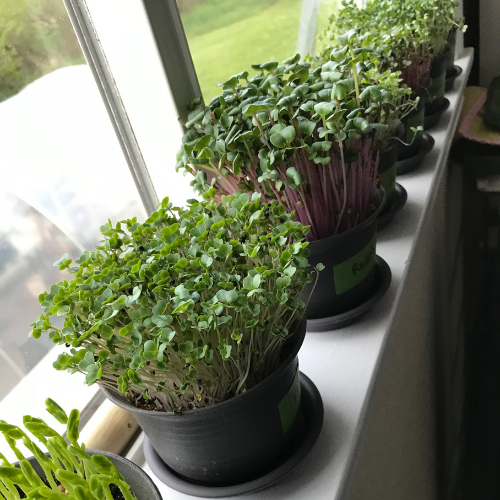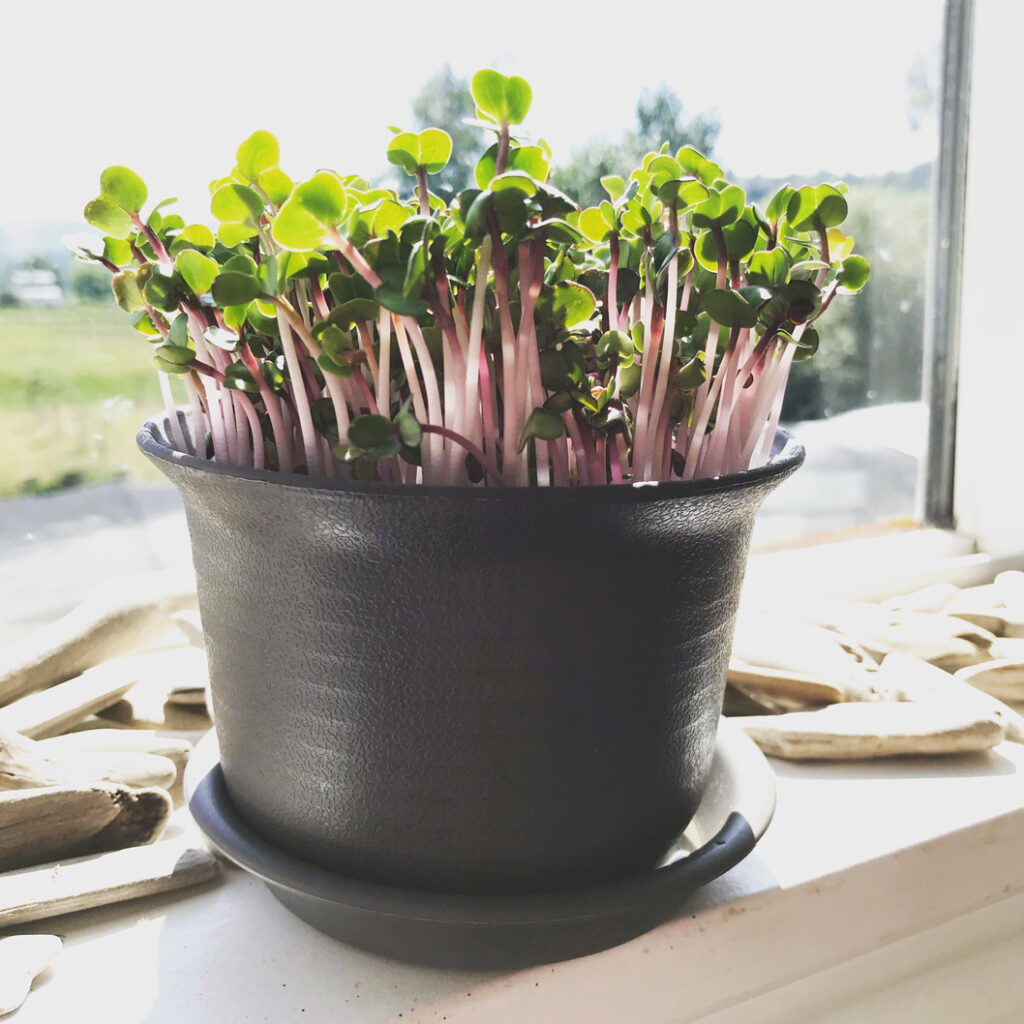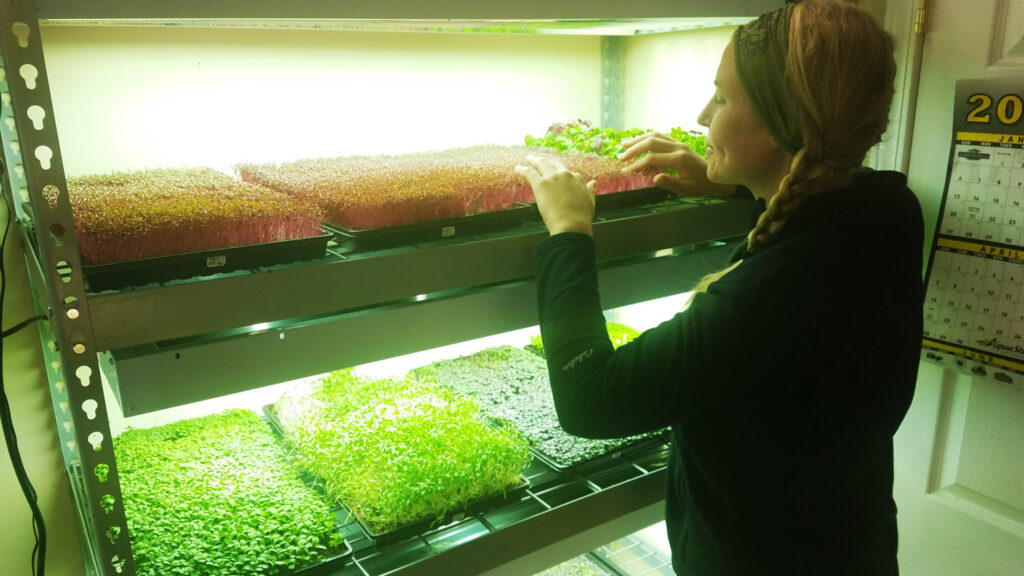If you are new to growing Microgreens you most likely have several questions. What kind of grow lights you need to grow microgreens? Do you need any at all? It can be a little overwhelming to start looking at LED vs Florescent… WATTS vs lumens… Light Spectrums and Kelvin ratings.
How many hours a day should your microgreens get light?
How close should the lights be?
If any of the questions are resonating with you, read on! This blog will hopefully provide you with some clarity. A word of warning though… there are no absolutes. Microgreens can grow in a wide variety of conditions.
I encourage you to take in the information and then decide what makes the most sense for your purposes. You may need to experiment a bit to see what gets you the best results in your unique growing environment.
Microgreens grow well with many different types of light sources.
The type of light you choose to use will be different depending on your microgreens goals.
If you are growing microgreens for personal use at home using sunlight may be perfectly adequate. Microgreens grow great on window sills or even with indirect light on a shelf or counter top.

To grow microgreens on a larger scale, you may consider supplemental lighting particularly if you plan to grow vertically using a rack system. Artificial or supplemental light can help you plan for reliable harvest dates year round.
Lets review some of the common lighting options. We will look at both the pros and cons of each.
LIGHT SOURCE OPTIONS FOR GROWING MICROGREENS
Sunlight
Sunlight is a great option. The sun provides the most complete spectrum of light available. What more, its FREE!!! Using natural sunlight is often a great option for the home grower. A window sill or greenhouse can work great! If you are growing on a larger scale you can grow on tables in a high tunnel or greenhouse. While this does take up more room than growing vertically, it might be a great option if you have the space.
Pros:
- free
- simple
- natural
- readily available
- no wiring or timers required
- complete light spectrum in the 6500k range on a clear day
Cons:
- inconsistent due to seasons and weather
- produces heat which can exceed desired temps
- does not work well in vertical rack systems due to shadowing
- supplemental lighting may be needed in winter months

Fluorescent Lights
Fluorescent lights are an inexpensive option. While the upfront cost is minimal (this is probably your cheapest artificial light option), it’s worth noting that these light cost more to run (than LED’s). There are a wide variety of options when it comes to sizes of fluorescent light and they are widely available.
Pros:
- inexpensive
- widely available (most likely will not need to be special ordered)
Cons:
- use more power to run
- produce more radiant heat
- bulbs may contain mercury which can contaminate your grow area if the bulbs are broken
LED Bulb Shop Lights
Many growers prefer to use LED shop lights (rather than fluorescents) because the are more efficient and thus less costly to run. These can be purchased in most big box stores and over the years have become much less expensive. Standard 4 foot long size are readily available and work well with a vertical rack system. Growing vertically allows you to grow a significant amount of microgreens in a very small space.
Pros:
- accessible
- inexpensive
- adequate light spectrum 2200k-4000k for microgreen growth
- produces minimal heat
- can usually be daisy chained 3-4 lights (to minimize cord mess)
- works with 120v household electrical outlets
Cons:
- Bulbs are often unprotected from water and dust making them susceptible to damage
- brands vary greatly in quality
- normally designed to be installed horizontally only
- less efficient than strip LEDs
- generally last far fewer hours than strip lights
- light spectrum too low for longer growing crops (slower growing crops may become discolored or very tall/leggy- falling over before harvest)
LED Strip Grow Lights (T5)
Grow light strips like T5’s provide a fuller light spectrum (above 450k). These can be purchase in a variety of lengths such as 2 ft, 4 ft etc. Many come with reflectors which help redirect the light and increase efficiency. These type of grow light are more expensive, but may be a good option for a small scale commercial grower.
Pros:
- Full light spectrum 4500k and above allows for longer growing periods
- produces minimal heat
- efficient watt to lumen ratio
- some will offer lighting surfaces that are protected for dust and water
- can usually be daisy chained up to 7 lights
- most work with 120v household electrical outlets
- some can be installed vertically if needed for your set up
Cons:
- More expensive
- quality, efficiency, and longevity can vary greatly between brands
LED Panel Lights
These are the top of line growing lights for indoor use. They are generally used in larger scale commercial growing of plants that need to reach full size or produce flowers indoors. The high light intensity could be considered overkill for growing microgreens. Ranging in price from $99 into the $1,000s they can be very expensive for the limited growing area.
Pros:
- come in a variety of sizes
- intense full spectrum light capabilities
- variable sizes for customized growing spaces
- highly efficient watt to lumen ratio
Cons:
- Expensive
- thick profile limits their ability to work in vertical rack systems
- generally require separate ballasts for electricity
- must be purchased from specialty suppliers online or in hydroponic stores if they are available in your area

How High Should I hang my lights above my Microgreens?
It depends on what kind of light source your are using. The heat produced by the lights is a factor. Lights that generate more heat will require more distance (so you won’t burn or stress your growing microgreens). Most LED strip lights do not generate enough heat to cause problems and do well 6-12 inches from the surface of the growing greens. The farther the greens are from the light source the more they will “stretch” and become tall or “leggy”.
Panel lights are higher intensity and can be placed farther from the growing surface while still proving plenty of light.
How many hours of light do microgreens need?
There are many different opinions on this. General rule is that plants need AT LEAST 6 hours a day of light to grow. If sunlight is your main light source, you are of course limited to the hours available to you. Being aware of shade patterns and light direction when setting up your system can help you get the most from your hours.
If you are using artificial or supplemental light you have the control to experiment with what works best for you. Some growers keep lights on 24/7 to speed growth. Others use a modified daylight schedule of 18 hours on 6 hours off. Personally I use an 12 hours on 12 hours off (aprox). Here there is a happy medium between extra light hours to speed growth and allowing the plants “resting” time. I find that the colors and flavors are more ideal when the plants can rest in the growing cycle. Experiment with different light cycles and see what works best for you!
You can purchase simple and relatively inexpensive timers if you want to make use of that type of setup.
What’s up with light spectrums and the Kelvin Scale?
Most lights will be labeled between 2000K to 6500k. The K stand for Kelvin. Kelvin (K) is the base unit for thermodynamic temperature in the International System of Units (SI), equal in magnitude to the degree of Celsius. Basically, Kelvin is used in lighting to measure the color temperature of a particular bulb.
The lower end of this scale, color temperatures from 2000K to 3000K, are referred to as “warm white” and range from orange to yellow-white in appearance.
Color temperatures between 3100K and 4500K are referred to as “cool white.” This range will emit a neutral white light.
Above 4500K will give off a blue-white light that mimics daylight.
Because most microgreens grow for short periods of time the light spectrum is less important than plants with longer growth cycles or into a flowering stage. In growing micro herbs or other plants longer than 20 days it is advisable to use lights that produce a color temperature above 4500k.
Lumens and Watts
Lumens to Watts is another term you will see in a lot of light comparisons. This refers to the amount of light produced per watt of electricity used. If you are concerned about how costly lights will be to run and how much electricity they will require this is important to pay attention to. You will see by comparing Lumens to Watts that LEDs are the more efficient type of bulbs.
Hope this blogpost has helped to clarify what lighting options are out there for Microgreen Growers. There is not so much a “right and a wrong” as there is a “more or less ideal” depending on your goals as a grower. Like many other aspects of growing, this can be highly individual and may require some experimenting!
Happy Growing!!



